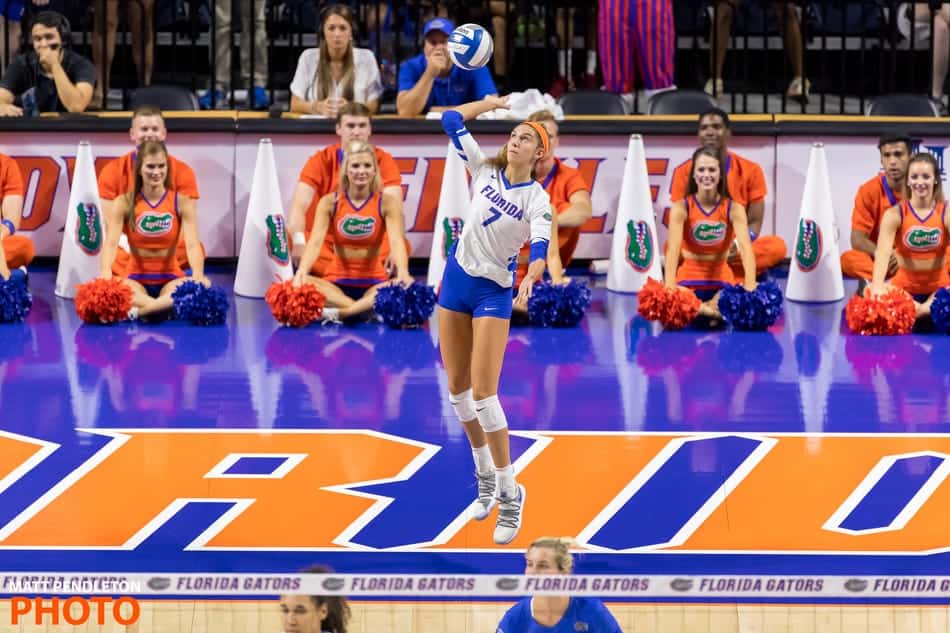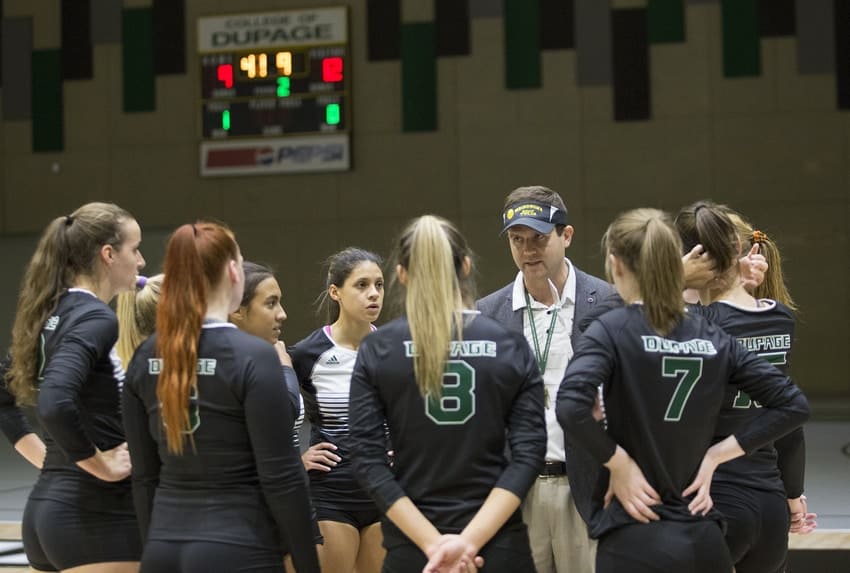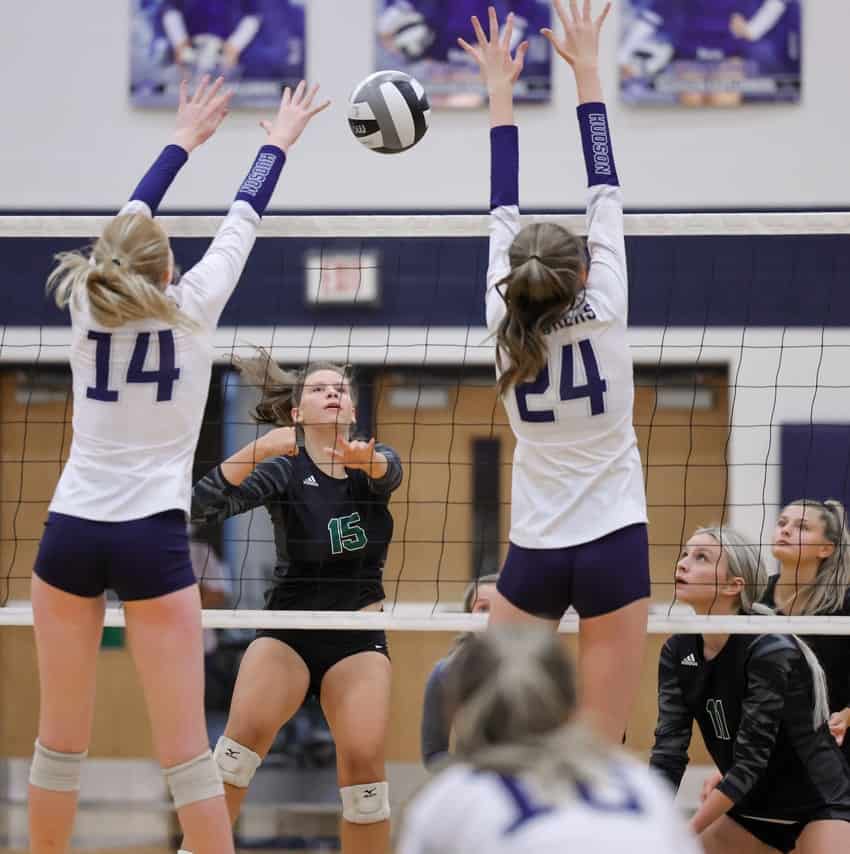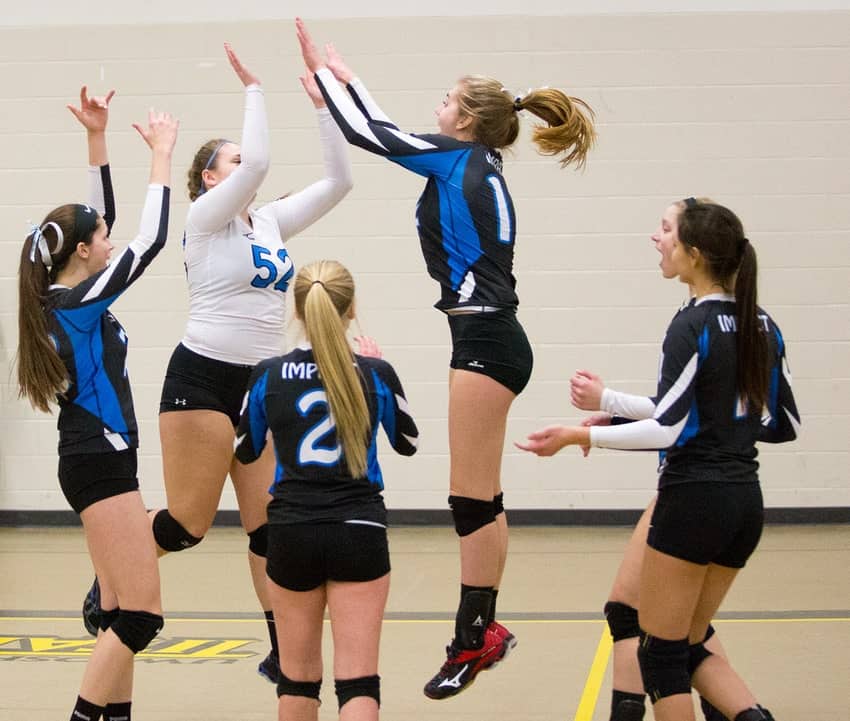If you have your sights set on playing at the college level, it can be intimidating to start your recruiting journey. It’s an exciting time, but also nerve-racking and it’s very easy to feel like you’re not sure what to do next.
Getting recruited to play as an athlete on scholarship is a process you’ll only do once in your life and most of the people around you have never faced this process before. Here are some tips on how to begin the recruiting process…
Last year, I helped my daughter Heidie to navigate this process and it can be hard to know what you don’t know. Here’s my master list of all the different parts of college recruiting in volleyball with some helpful thoughts and tips for each.
Do You Want To Get a Jump Start on Recruiting?
If you already know that you want to work with the best recruiting platform and service, we HIGHLY recommend Next College Student Athlete…
17 Steps and Tips in Your College Volleyball Recruiting Process:
1. Making Your College List
Be specific about your choices, which school would you really like to play for? When you’re beginning this process include a few schools (around 5) that you don’t think you’d ever be good enough to play for, many mid-range schools you think you could play for (10-15), and a few lower-level schools that you know you could play for (another 5+).
Begin with a long list, 20+ is a good starting point, some players start with 50-75! By starting with a large list you give yourself a better chance of finding a school that really fits your ability level, your social comfort, and a team that needs you.

There are a lot of lower-level schools that don’t get as much attention from players that have great programs. Your college experience may turn out completely different, just because you took the time to think outside the box when creating this list.
NCAA Division 1 and Division 2, NAIA, and many Junior colleges offer athletic scholarships. If you’re fortunate enough to earn a scholarship in Division 1, it will be a scholarship that covers all your expenses – what we usually call a “full ride.”
NCAA Division 3 schools don’t offer volleyball scholarships but may be able to offer you academic or possibly merit-based or need-based financial aid. These can still be a great option for players that really love the sport and want the experience of being a college athlete.
If you would like help with this step, I go through all the factors you should consider when making your list in this post called: How To Make A College Target List.
2. Make A Recruiting Video
Coaches receive so many recruiting videos and highlight videos. People often put a ton of time, effort, and money into the wrong things in these video clips. You should plan to do one introduction recruiting video and then make highlight videos that you can continue to send as you continue to play.
Here are some recruiting video pointers:
- Don’t make the video too long. Many coaches decide within 1 minute whether they’re interested. Most coaches will not watch over 5 minutes and almost none will watch past 10, so don’t make it 30 minutes long! That’s a lot of work in editing for no reason.
- Don’t worry about the hype and beauty as much as you would think. The coach isn’t recruiting you to be a video producer, they’re recruiting you to play! Having some music is fine, but coaches often mute it anyway, so don’t put a lot of effort into that part either.
- At the beginning of your video, make your introduction very simple and brief. This can even be one slide or screen that displays for 3-5 seconds so the coach can snap a screenshot with the information. Include your name, your position, and your graduation year. If you have good grades include your GPA and if you’re tall, include your height.
- What TO focus on in the editing process: At the beginning of every play in your video, make it simple for the coach to see you. You can use a highlight bubble, and arrow, whatever, but help them find you immediately.
- It’s not bad to have the video frozen for just a second or two to give them a moment to separate the last play from this one and identify you. The video doesn’t have to be professional, but you want it to be easy to watch – smooth and stable picture, in focus and zoomed in enough to see the action.
- And of course, include your best contacts (touches). Include as many of the different skills as you can that show a wide variety of your abilities. Try to pick clips that show you making a successful play with good technique, not just winning the point.
My daughter Heidie and I just made her first recruiting video, here it is below to give you an idea what we came up with.
Recruiting videos are just a tool, but in today’s world, they’re a very important tool. If you’re serious about getting a spot on a college team, you need to make them.
Bonus Tip: Post this video online, whether it’s on YouTube or on a site you control. That way you can share the video by just emailing or texting a link, with anyone, anywhere, anytime. You can do this for free, so why not just make it super accessible?
Bonus Tip #2: Make a new, fresh video often throughout the year and send it out to the coaches you’re most interested in playing for at this point. These don’t have to be a big, long production, just your best plays from your latest game are fine. Including a simple note that you wanted to show them how you’ve been improving recently will give them an update on you. Include footage of recent tournaments, games, or even practice if that’s all you have.
3. Personally Reach Out To Coaches (Email)
As you begin your recruiting relationship with a school and coach, you need to take the first step and get on their radar. In most cases, this will start with an email to introduce yourself.
You want to include your recruiting video – link it right in the email. Include your position, any statistics you’d like them to know, and the name of the school and club teams you play for.

When you’re reaching out to show your interest at a given school, make it personal. Some players will spam email to a long list of schools and basically use a form letter. It will attract the coach’s attention when you do the opposite.
Include specific and personal details when addressing the coach. Why do you want to play for her or him? What do you like about how they run their team?
Point out something you like about the school that shows you’ve researched it. Include positive points whether it’s the driving distance, a strong program they have for a particular major you’re considering, or some other quality that makes that school stand out.
4. Handle Your Own Recruiting Process As Much As Possible
After you’ve made your list, created a video, and emailed your target coaches for the first time, your next step is to personally call them to introduce yourself. You should wait a short time after the email so that they’ve had a chance to see it and respond. If they haven’t responded to your email, mention the email during the call and confirm that they’ve gotten your email and seen your video.
Your parents, and your high school coach or club coach, are going to be able to help you through a lot of the process of getting recruited and choosing a school. One thing that makes a BIG IMPRESSION on a coach is when a player handles their business more than their parents.
When it comes time to call a coach for the first time, YOU make the call. You’ll be nervous, but remember that everyone is. Coaches know that, and they will be understanding. They have these conversations all the time!
Prepare ahead of time by having a few short questions written in front of you so that you don’t freeze up. These can be simple questions like: “Can you tell me about your coaching philosophy?” or “Are you recruiting <your position> this season?” or even “What is it like to live in <insert city name>?” These are the soft question that let the coach pitch their school to you and make them feel at ease.
If you get their voicemail, don’t hesitate, leave a message! Be professional and speak slowly and clearly. Tell them your name, what year you are graduating from high school and what position you play. It’s a great idea to tell them you’ll call back on a specific day, but then make sure to do it!
5. Volleyball Clubs Matter
College coaches have relationships with high school coaches and club coaches. Many times college coaches who have good results recruiting players out of a specific club will go back to that club year after year asking who they have coming up.
One reason the club season is so important is that it’s the off-season for the college coach. They can’t come and watch many high school games because they’re busy playing their college season. During their off-season, they can go to a club tournament and watch hundreds of players in one weekend.

You want to play for as competitive a team as you can because you want the coach to see a high skill level. If they see you dominating a weak team in a weak league it’s difficult for them to evaluate how well you would do against college-level players.
As you’re playing through your high school years, when you choose a club, ask about how many of their seniors get scholarships. If you already have specific schools on your shortlist, ask if the club has any connections with that school.
It’s not a deal-breaker if the club says that they don’t currently have a connection with your hopeful college. Watch for the answer they give you. Many clubs totally get how important this is, and will immediately offer to reach out to that school and start building that bridge if you come to play for their team.
If you would like to learn more about volleyball clubs and how to choose the right one for you, check out this article next.
6. Try To Attend A Major Tournament or Two That You Can Invite Coaches To
Every year there are major tournaments in each area of the country that are the perfect spot for coaches to scout their talent. These tournaments are often 3-day tournaments that host 900-1000 teams.
You want to pick a tournament that’s in the region or area of as many of the college teams you’re interested in playing for as possible. Make it easy for as many coaches on your list as possible by picking one of the tournaments nearby and targeting that one.
You want to look up the USA Volleyball National Qualifier Tournaments here.
These tournaments begin in March and there are several each weekend. Ideally, you would play for a club that’s already planning to compete at one of these and then you go with your regular team. But, you can actually go and compete on your own by signing up individually to join a team as long as there’s still space.
Another option is to go to non-qualifier tournaments.
The Junior Volleyball Association organizes several of these each year, which you can find here.
The idea here is NOT that you just go and hope a coach notices you out of thousands of players. You want to invite each and every coach that’s on your list. Remind them of your club team, not just the name of the club. Whether you’re called 16-2 or 17-Pink, however, your name is listed on the tournament website or app, so they can easily find you on the courts.
If you aren’t able to attend one of these major tournaments invite the coaches on your list to all of the tournaments you will be playing in. You can especially draw attention to the tournament that’s closest to the college, but remember, these coaches are traveling as well and you never know if they’ll have another reason to be in the area you are.
Another option is to see if there are any camps they will be participating in during this season. This is less effective because you may be picking to target just one coach per camp.
When you have coaches come and watch you play, don’t be surprised if they don’t stay long. Many times players are broken-hearted and discouraged if they see a coach come and watch them during a game and they don’t stay for the whole match.
Remember that this coach may have a lot of other players at the same tournament to try to see and they are trying to accomplish their job during this tournament. Coaches often have specific things they’re looking for and may make some really quick judgments about you and whether you are the player they want or not.
7. Show Your Personality
Sure the coach is looking for a player to fit a particular position on their team and they want strong stats and strong fundamental skills. But the coach is also recruiting a person. Let them see a little of your personality.
When a coach gets to watch you play, they notice things like how you respond to adversity. How do you communicate with your team? How do you handle it when your coach gets on to you? Do you pay attention in the huddles and are you engaged when you’re off the court?
When the decision is close, all other things being equal, you want them to want you. Make it easy for the coach to think “That kid will be great for my team!” Don’t pretend to be something you’re not, but be comfortable enough with yourself to show your personality.

8. Be Ready For The Process To Begin Early
The higher the level of school you are hoping to play for, the earlier you should engage in the recruiting process. In general, hitters need to start earlier than the other positions. It’s common for the highest level of college coaches to make verbal offers to players who are freshmen and even in the 8th grade.
If you play setter, libero, or defensive specialist, don’t expect coaches to fill those positions as early. These positions are less dependent on height (which is a factor that won’t change much later on) and more dependent on skills (which you are hopefully refining through the years). Coaches feel the need to lock in those hitters early because the recruiting for them is so competitive they don’t want to miss out.
The lower tiers of college teams fill up their last recruiting spots, sometimes all the way down to what would seem like the last minute. So if you really want to play, DON’T GIVE UP!
If you would like to go more in depth about getting started and your timeline, this post is for you.
9. Know Some Of Your Key Stats And Work To Improve Them
Depending on the level of college you are trying to play for, statistics may really determine your chances of getting the scholarship offer. Height and vertical jump are huge factors for the hitting and blocking positions. You can’t change your height, but you can add a few inches to your approach jump just by using focused exercises to improve it.
If you are determined to get that spot and you know that a particular stat you have is weak, work to improve it! Talk to your coaches and see what drills or exercises you can do to improve.
You may want to consider hiring a personal trainer that specifically works with volleyball players. Sometimes a few sessions with them can really help you make a big change. There are gyms that specialize in helping young athletes improve particular aspects of their game, do a search to find one in your area.
10. Find Out Where You Stand
Later in the recruiting process, after you’ve built a relationship with the coach, ask them where you stand. Ask them what their timeline is for when they will be making the decision to offer scholarships. If you’re planning to make an unofficial visit and this school is not just down the road, you want to know the answer before you spend the time and money to go visit campus.
Before you ask the question, prepare yourself. You may not hear the answer you were hoping for. Be ready to handle the response professionally, not emotionally. Don’t handle it poorly because things can sometimes change. How you handle this conversation may determine whether or not they may change their mind down the road.
Remember that you’d like to know earlier, rather than later, if there’s little to no chance that they have a spot for you. You would hate to keep pouring your time and energy into this school when maybe the next one on your list has a much better chance of working out.
11. Your Visit To Campus
When you do visit the campus, think about what your college life will be like. Of course, you’re going to consider the volleyball program but also think about the rest of the school.
If you were injured and had to sit out from volleyball for the next 6 months, would you be happy here? What are their facilities like? What’s the atmosphere like around the school?

Consider the schedule your coach keeps and the program that they run. Talk to current players and ask them more than just the surface questions. Ask them things like how much they train in the off-season and the summer.
Be humble and consider the impression you’re making on them, this could be your team one day. If you build some trust with them and spend some quality time you may get some insight that helps you really know whether you’ll be happy there or not.
Whenever you’re on campus, be conscious of your choices. You never know when you will be seen by someone that could have an impact on your future and you may not even recognize them!
When I was visiting the college I ended up attending, I had an individual tour. The guide introduced me to a friendly young man in shorts and a T-shirt coming off the racquetball courts. We had a nice short conversation and as he walked away, the tour guide casually said, “That’s the Dean of your program, I think he likes you.”
If you’re offered the chance to practice with the team, I shouldn’t even have to tell you, but TAKE IT!!! This is a golden opportunity and whether you make the team or not, a really neat experience. If you do well, it’s not unusual for the coach to offer you a scholarship on the spot.
12. What To Do After Your Visit
Make sure to thank the coach and their staff and team for the time that they spent with you during your visit. They have many players that are interested and you want to leave them with a good taste in their mouth, just show appreciation.
After a little time has passed, it’s appropriate for you to ask where you stand on their list if they haven’t made it clear. You can also begin to ask questions about the admissions process and that may help you get a sense of what comes next.
13. Remember Your Position Can Still Change
You may have played a specific position for several seasons now and be pretty attached. I know my daughter Heidie found her comfort level as a setter after her second season and wouldn’t really expect to play anything else.
But if a good coach at a college you would like to play for asks, are you open to switching positions? You need to be ready for that conversation in case it ever comes. Players can be defensive about changing positions and get very emotional.
Coaches see things in us that we don’t realize. What a college coach may see in you may be different than what your high school coach has seen. They may know that you wouldn’t be successful at your current position, but that by changing, they could coach you into becoming great at something else.
Maybe you’ve always been the middle hitter because you were the best option around during high school. You may find out through the transition to college that outside hitter is really where you need to be!
That coach’s needs for his team might be different as well. They may not offer you a spot because they are loaded in a specific position, but they want you as a player. So try to be open-minded to trying a different role on the team at the next level.
14. Be A Student Of The Game
Coaches love to find players that have a high volleyball IQ. They love to see that when a coach gives direction you can understand quickly and make changes on the court. This doesn’t happen by accident or happen overnight.
Instead of just watching the game, study the game. Watch successful players at your position, whether live or on video, and study their habits, their techniques. Find a college team that you’d like to follow and make it a habit to study their games. Don’t watch as a fan, watch as a critic, and watch like a coach would watch.
A great way to raise your overall understanding of the game is to spend your leisure time reading websites like this one! Bookmark this site and come back from time to time. You never know when an article will teach you something you had never heard before or help a concept click in a way that it never has.
15. Don’t Forget About Your Academics
Remember that throughout this process you need to be investing enough time and energy into keeping up with the academic side of your life. You want to be in good standing when it comes time to qualify to play for your school.

Players should plan to take the ACT and SAT tests early so they can retake them later if they need to improve their scores. You can take it in your junior year and you can take each of these multiple times.
Besides the standardized testing, you need to maintain good grades as you finish high school. Don’t get so focused on your athletics that you let your grades slip, that would be unfortunate.
16. Understanding Scholarships
If you’re fortunate enough to get an offer from an NCAA Division 1 school, your scholarship will be a full ride. In volleyball, in D1 volleyball, you’re either a scholarship athlete or not.
When it comes to the other divisions and the NAIA, your coach has a scholarship budget that they can break up however they need to. They can choose to offer more to the best athletes, the positions they need the most, or to players that need the most financial assistance, it’s up to the school. D3 schools aren’t allowed to offer scholarships for athletics, but they will try to maximize any other scholarships you may qualify for.
As you enter this phase of the process, understand that this is a negotiation. You want to get the best deal you possibly can from the school that’s the highest on the list. The first thing is, no matter what the offer is, thank the coach sincerely.
Tell them you’ll need some time to think about it before giving them an answer. Ask them when they need an answer from you. Usually, coaches can give you a week or two.
Remember that we started with a list of 20, 50, or 75 schools? At this point in the process, you would love to have a handful of schools that are interested in you and offering you some level of scholarship. The reason is that that is the number 1 reason coaches will upgrade their offer.
After you have an offer in hand from one school, you need to reach out to the other schools on your list and find out where you stand. Coaches may need some time to figure out if they have enough in their budget to match or beat your initial offer. Other times, you’ll find out immediately that you simply weren’t that high on their list.
You don’t want to deceive coaches or keep schools hanging just to use for leverage, these should all be schools you are actually still interested in playing for. You have to find a way to balance not offending the coach, showing you are genuinely interested in playing for them, and getting the most help financially so that you can make a good decision to play there. This part of the process can take some serious engagement where you are communicating back and forth with different coaches and different financial aid offices.
Here’s another article that goes into more detail to help you Understanding Athletic Scholarships.
What you want to boil the scholarship down to is: Your Expected Contribution
Each school should offer you in a clear way – this is how much the entire cost of going to school here is, this is the total in scholarships we’re offering, and this is what you’re left paying. That’s the expected contribution number. Be careful that you don’t just take the biggest dollar amount offered, the tuition at that school might be twice as much!
During the negotiations, it’s much more tactful to use the expected contribution amount as a bargaining tool than just the dollar amount of the offer. Think how that sounds, “Coach, you’re my number 1 choice, but I just don’t see how I can come and play for you when it’s going to cost my family $—- more each year than going to this other school.”
17. Signing The Scholarship Deal
When you finally accept your best deal with the school of your choice, you’ll sign legal documents that make it official. Most colleges use the NIL (National Letter of Intent) or a modified version of this. Don’t worry it’s not too long, but it is official.
It’s important that you know and understand what you’re signing because this is a legally binding agreement. The school is offering you a scholarship package to play for them for one year. The scholarship can be renewed each year at the coach’s discretion.
Get started today with Next College Student Athlete.
Start by building a FREE profile in just a few moments and getting a tour around the platform.
We believe investing in a membership with NCSA was a major reason my daughter Heidie earned a scholarship with her school.
Are There College Volleyball Recruiting Camps?
While club tournaments are one of the most common places for a coach to watch you play live, there are camps you can choose to attend that are led by and attended by many, many coaches. Wouldn’t it be great to go to a camp that had 10-50 different college volleyball coaches meeting and interacting with you?
The drawback to this is the coaches on your list may not be going. But you can certainly invite them and you may get some interest from a school you haven’t considered before. Check out some camps near you this upcoming season at a site like Exact Sports.
Photo credits:
Feature image by K.M. Klemencic on flickr.com: https://creativecommons.org/publicdomain/mark/1.0/
Florida image by Matt Pendleton on flickr.com: https://creativecommons.org/licenses/by-nd/2.0/
Coach in the huddle image by COD Newsroom on flickr.com: https://creativecommons.org/licenses/by/2.0/, cropped to zoom.
Club team image by K.M. Klemencic on flickr.com: https://creativecommons.org/publicdomain/mark/1.0/
Celebration image by popo.uw23 on flickr.com: https://creativecommons.org/publicdomain/mark/1.0/
Student with headphones by Anastasiya Gepp from Pexels
Student writing image by Startup Stock Photos from Pexels
Recent Posts
Athletes, listen up! Do you have a closet full of old jerseys, sweatpants, and tees that you just can't seem to part with? Well, dust them off, because you're sitting on a goldmine of fashion...
You may have heard, or you may have noticed, that there's been a change to the rule about double contact in volleyball. In 2022, an experimental rule change began to be implemented, where the double...
